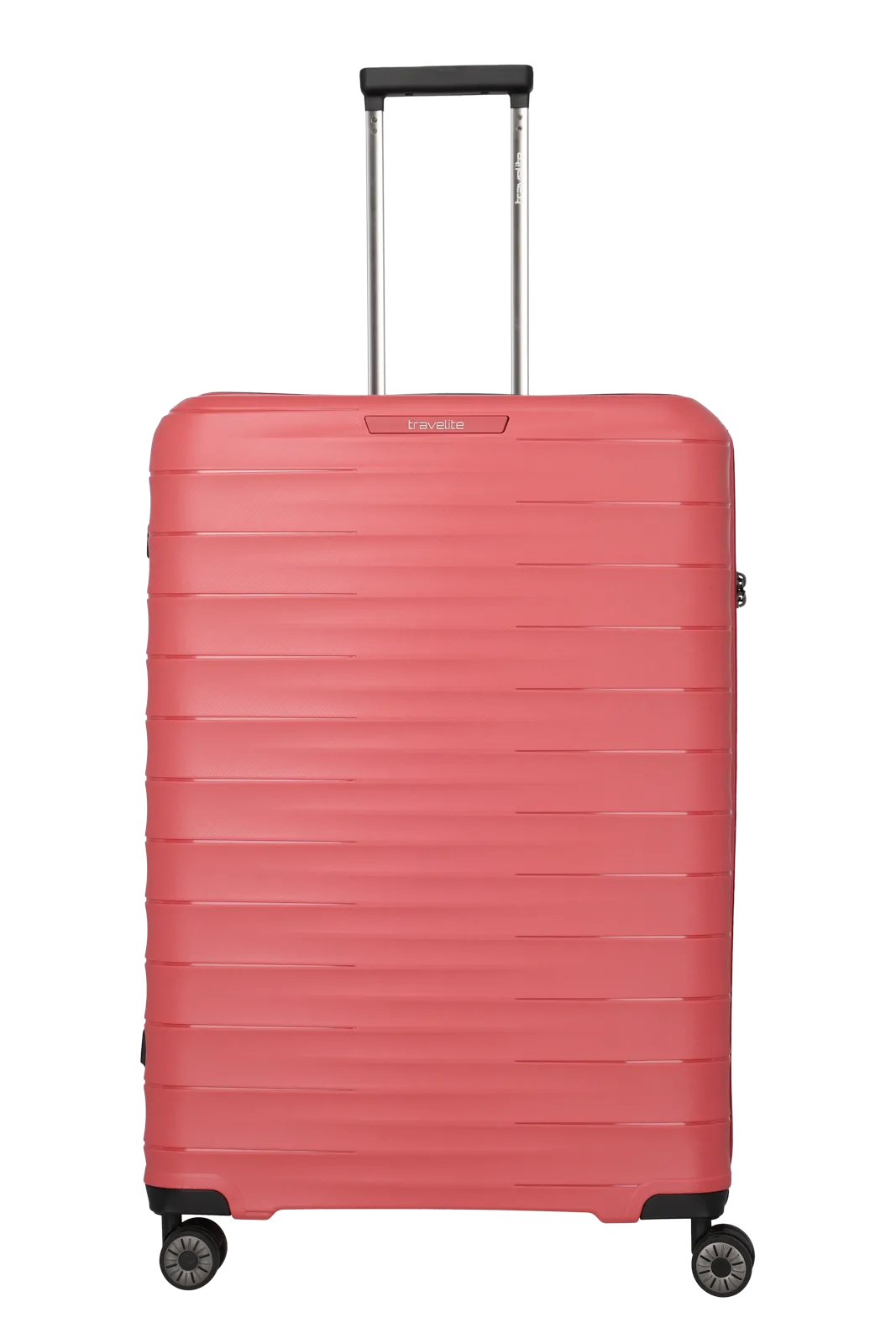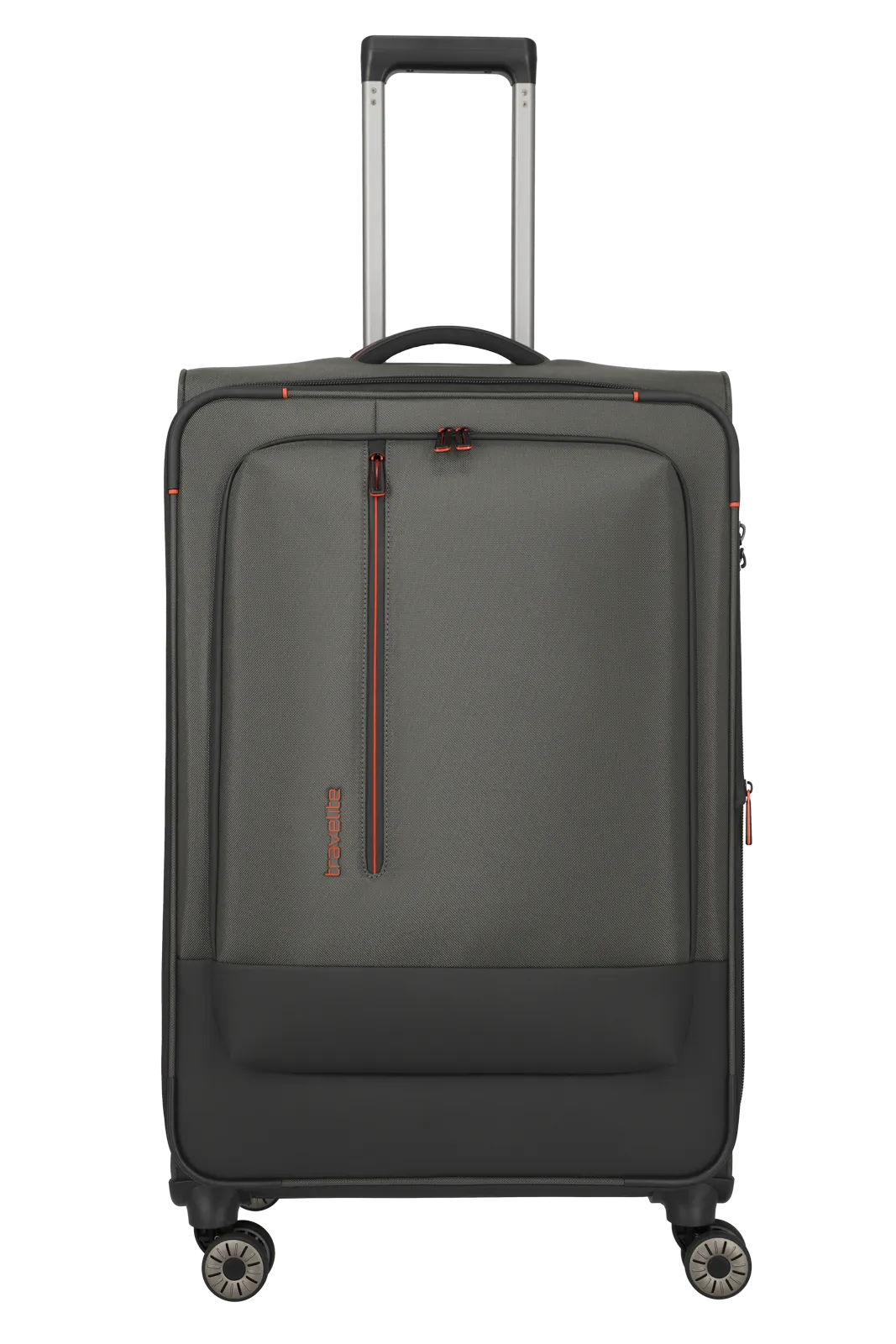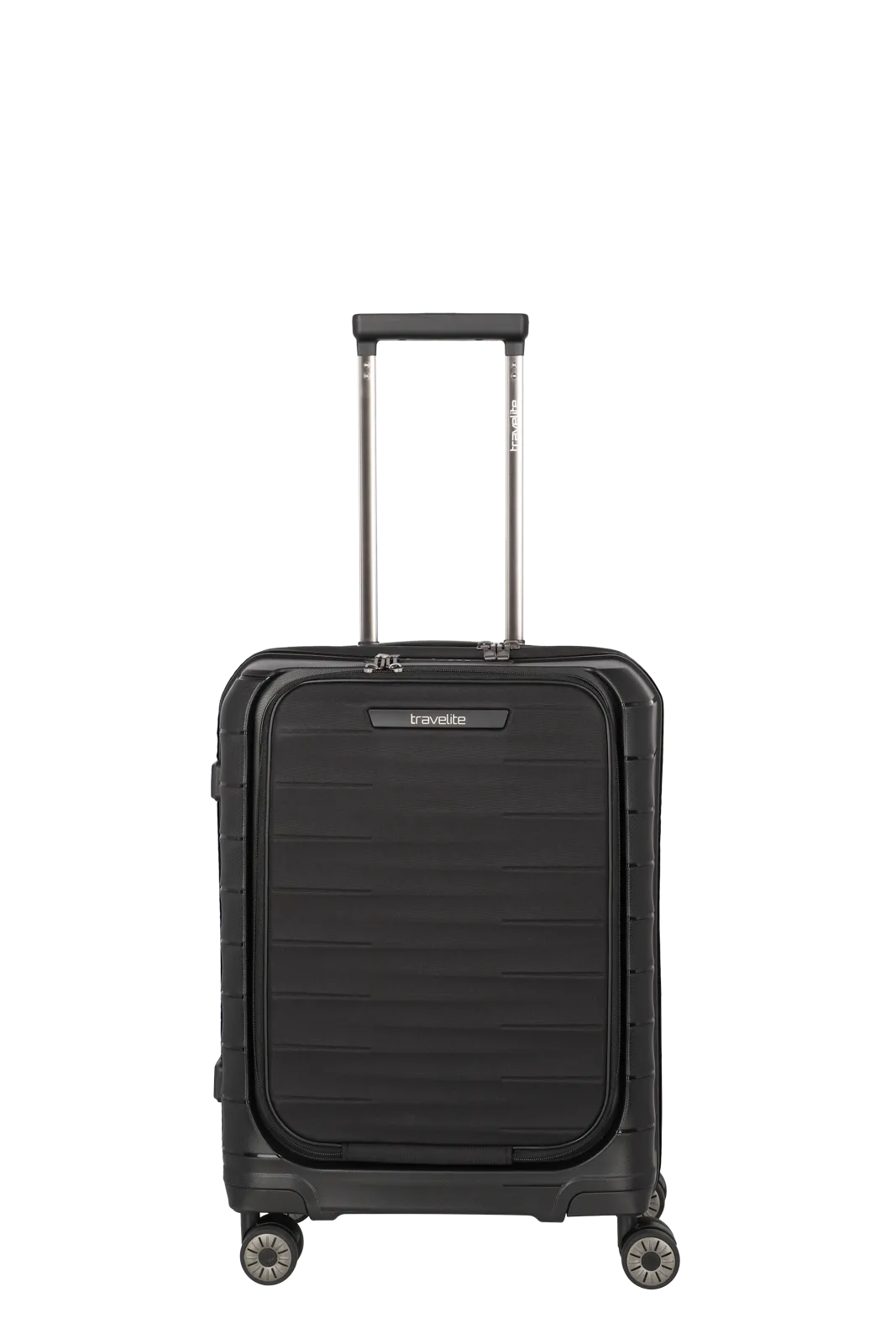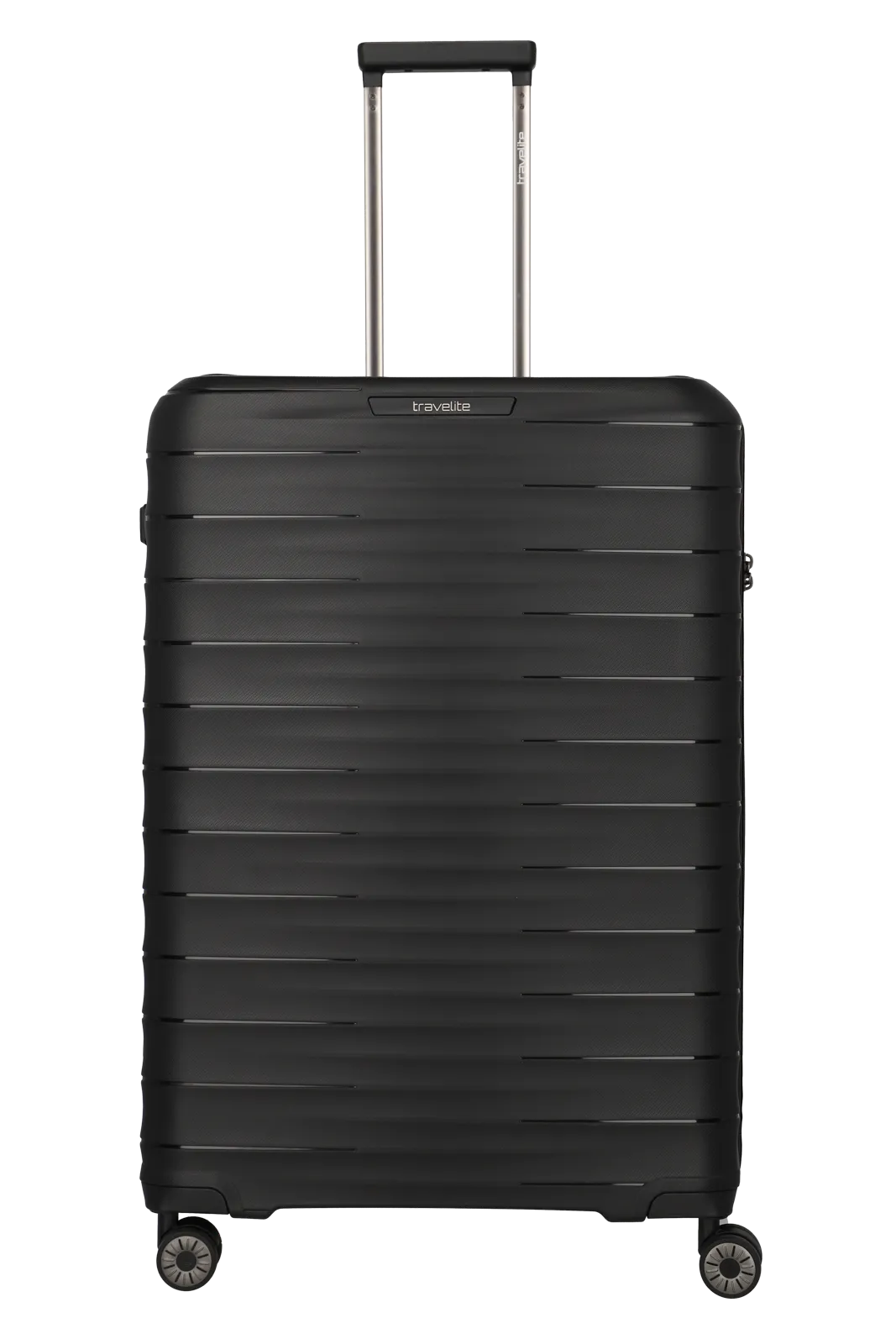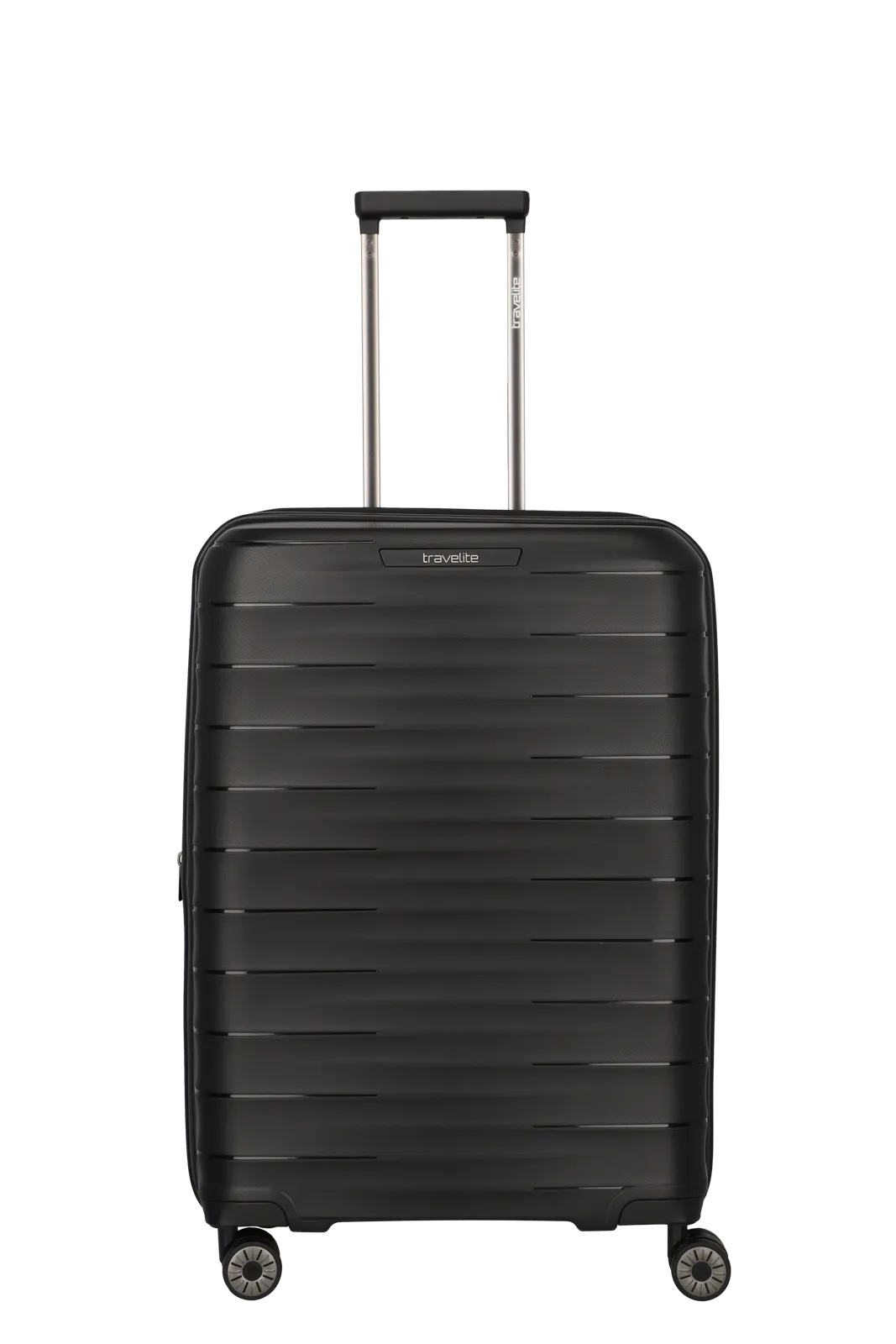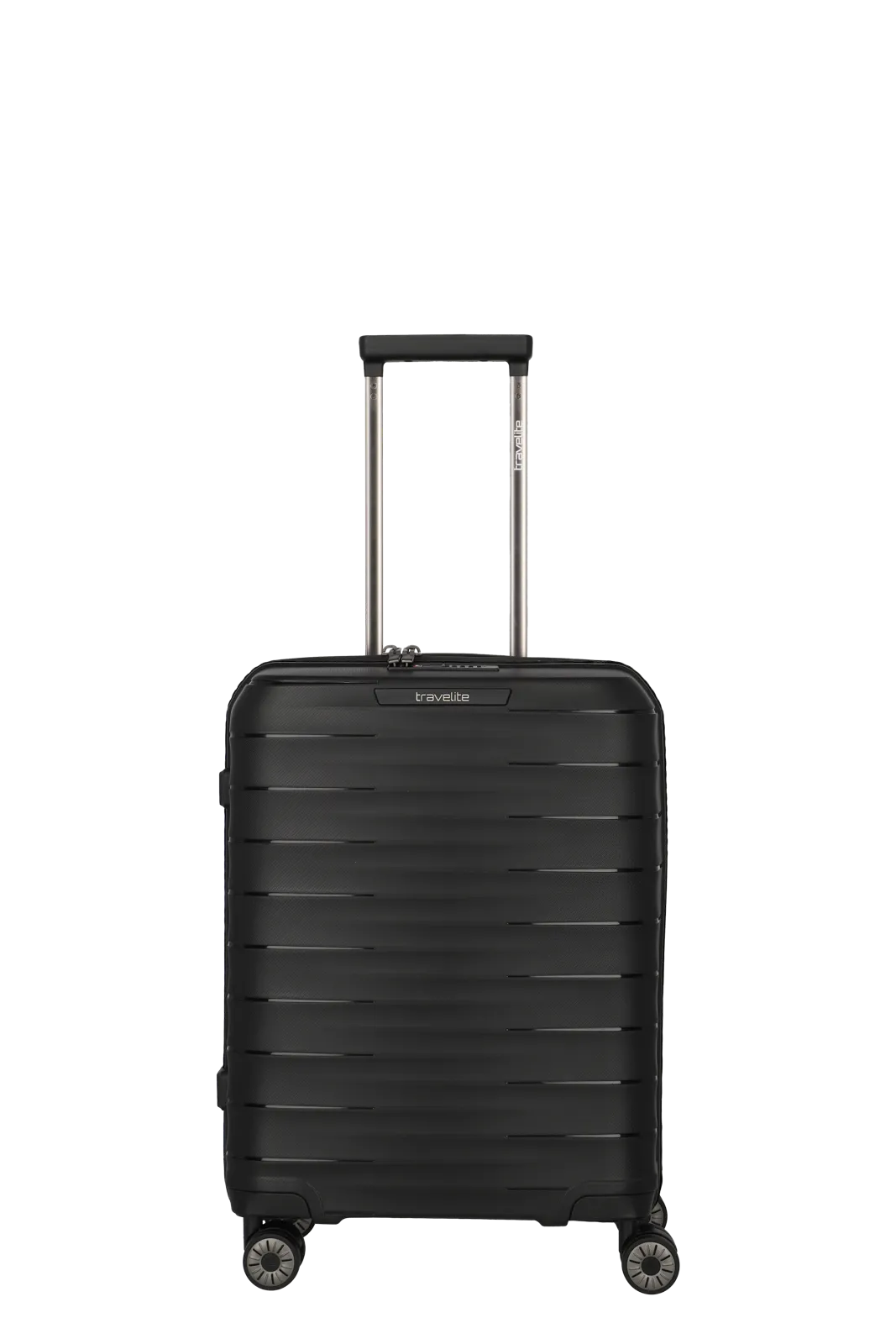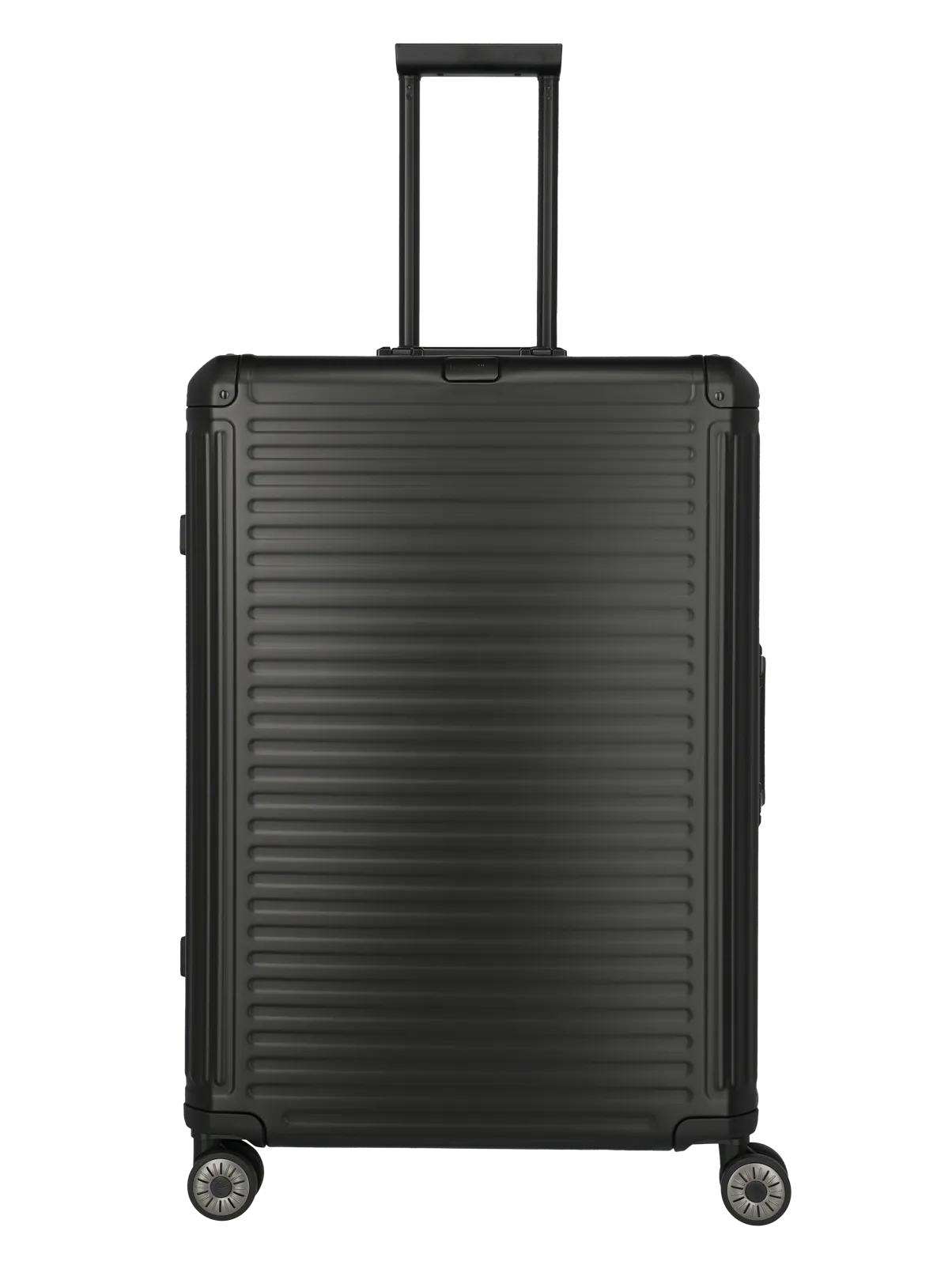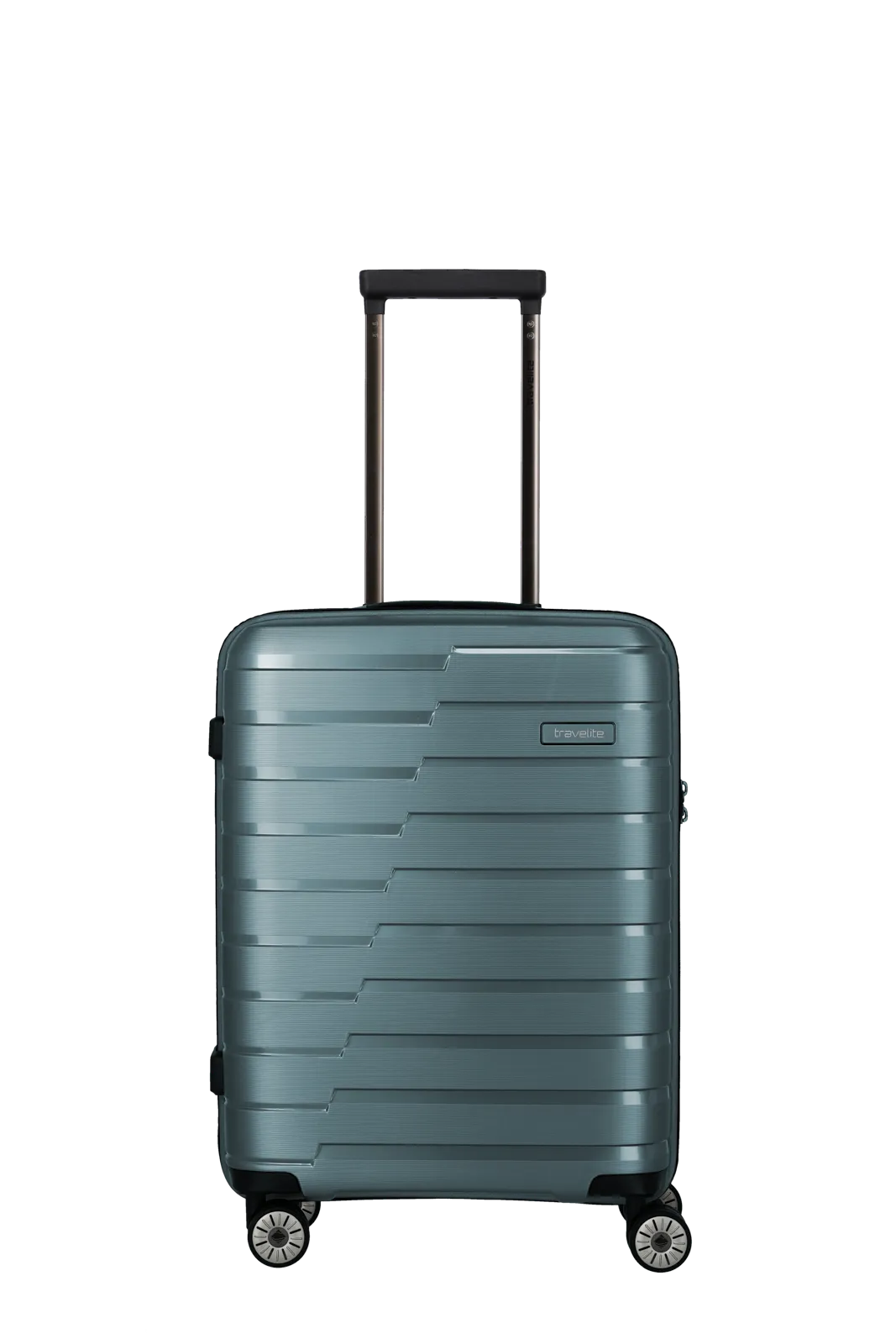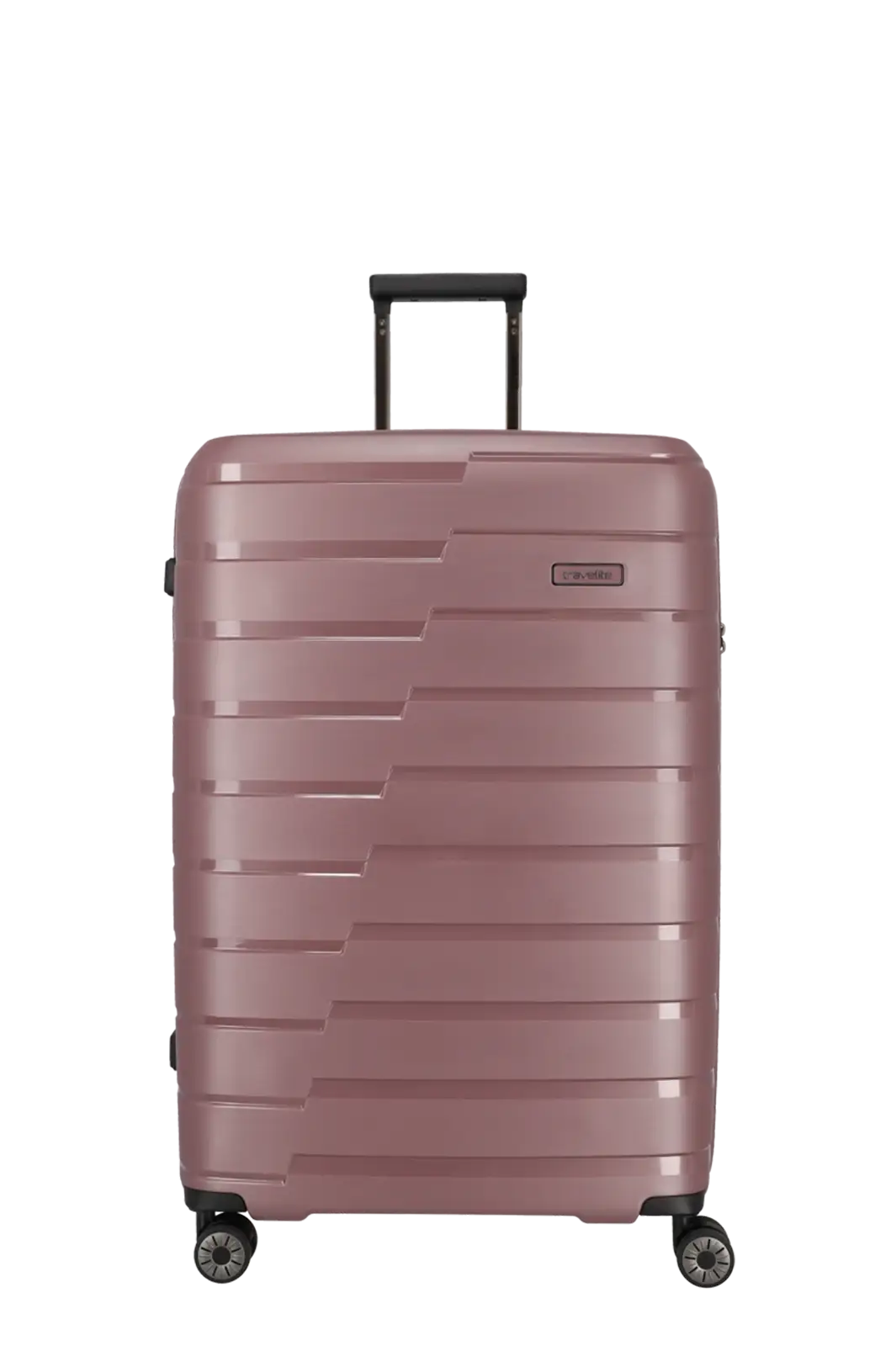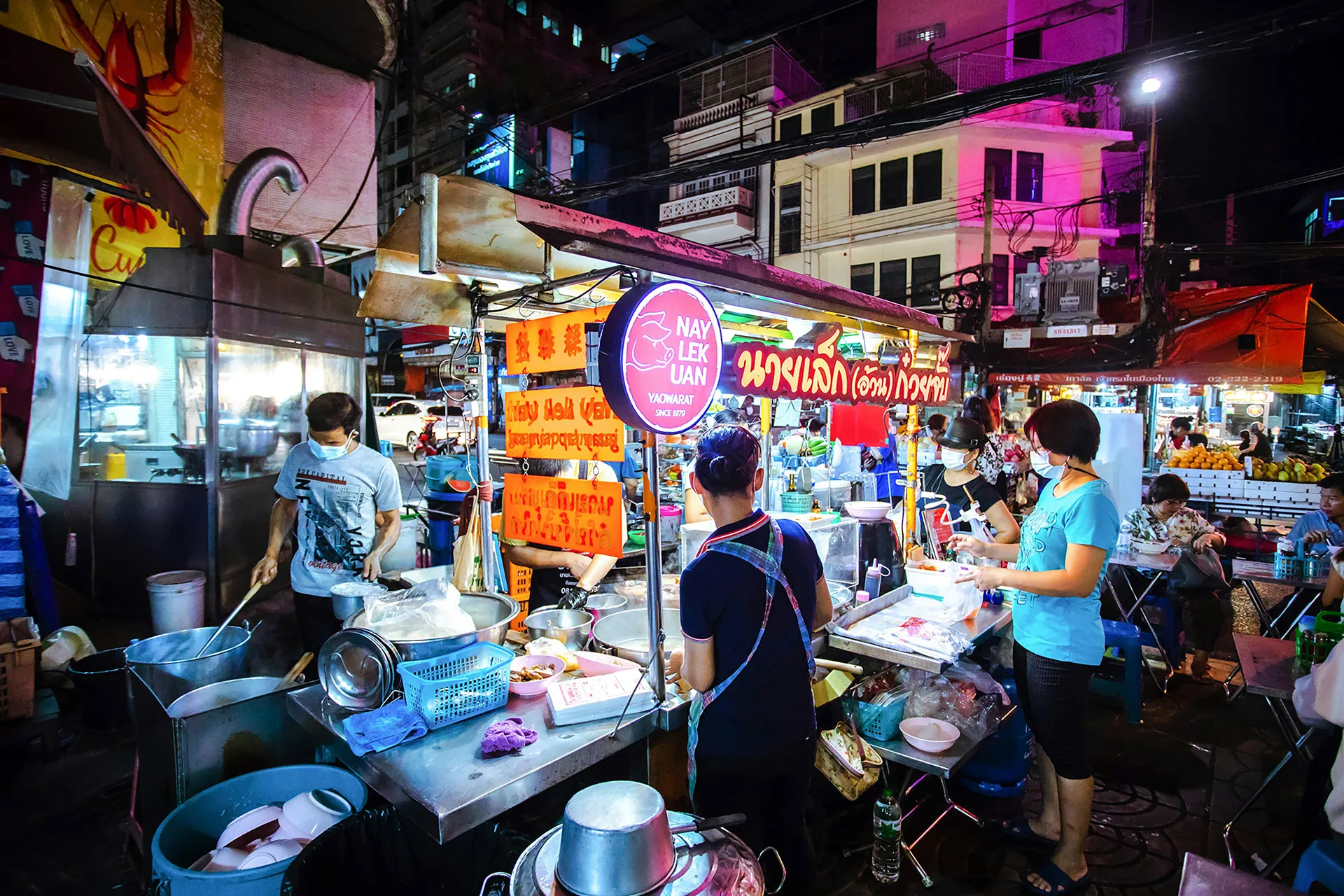

Street food tour through Thailand: a travel guide for gourmets
Street food tour through Thailand: a travel guide for gourmets
Spicy papaya salad, fried noodles with prawns, crispy coconut pancakes, grilled meat skewers with peanut sauce - if you want to experience one of the world's most popular cuisines, you should travel to Thailand. Whether in small street food restaurants or at colourful markets - unique dishes can be discovered everywhere. The variety is incredible, the flavours are exceptionally aromatic and the people who cook the delicacies are super friendly.
Content:
Foodspots Thailand: Here you can find the tastiest food
Tips & Rules: How to order and eat your food
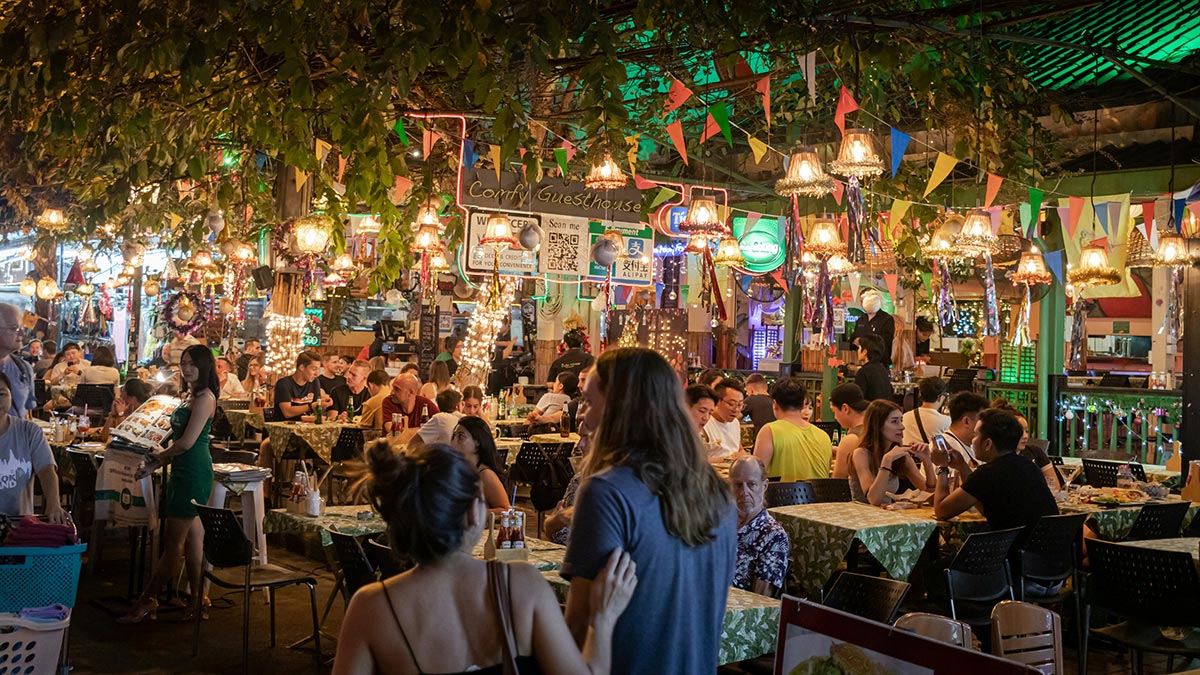
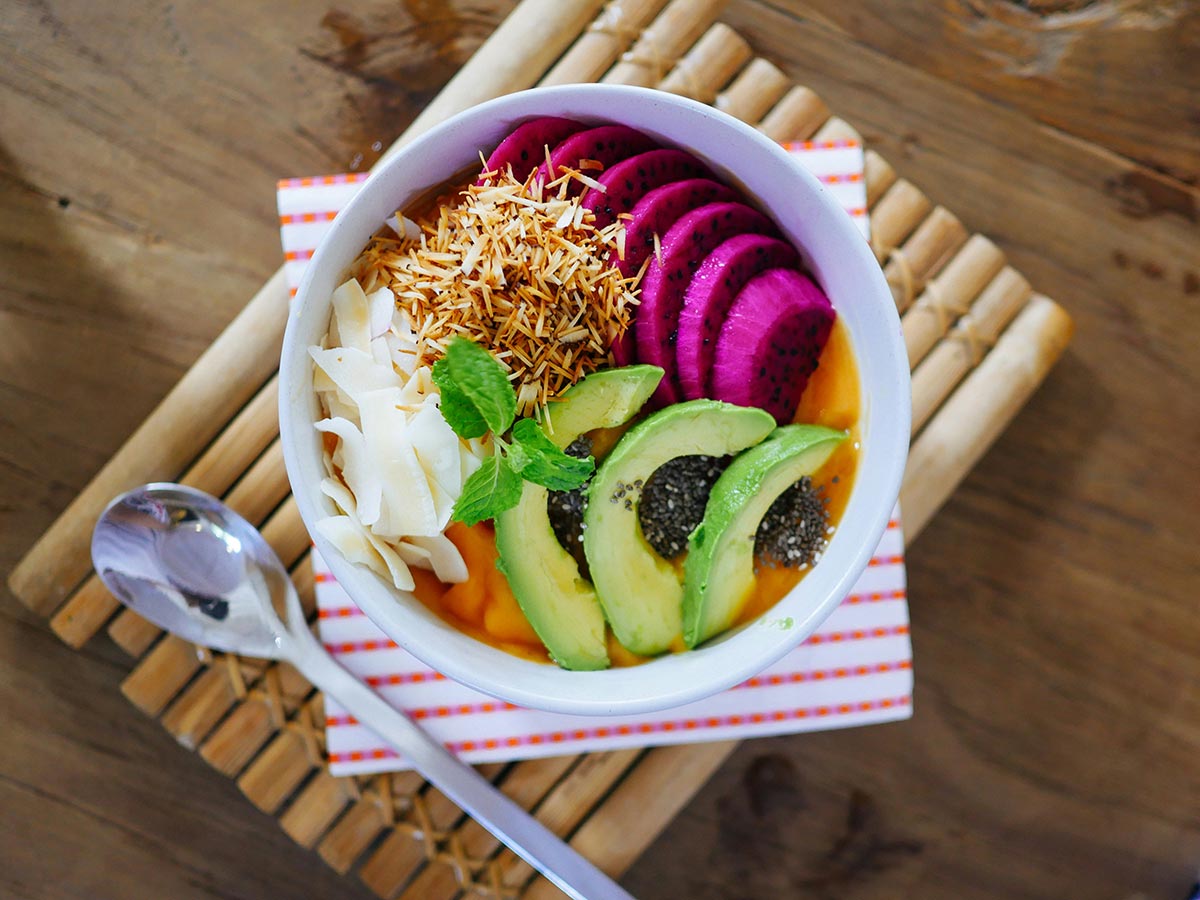
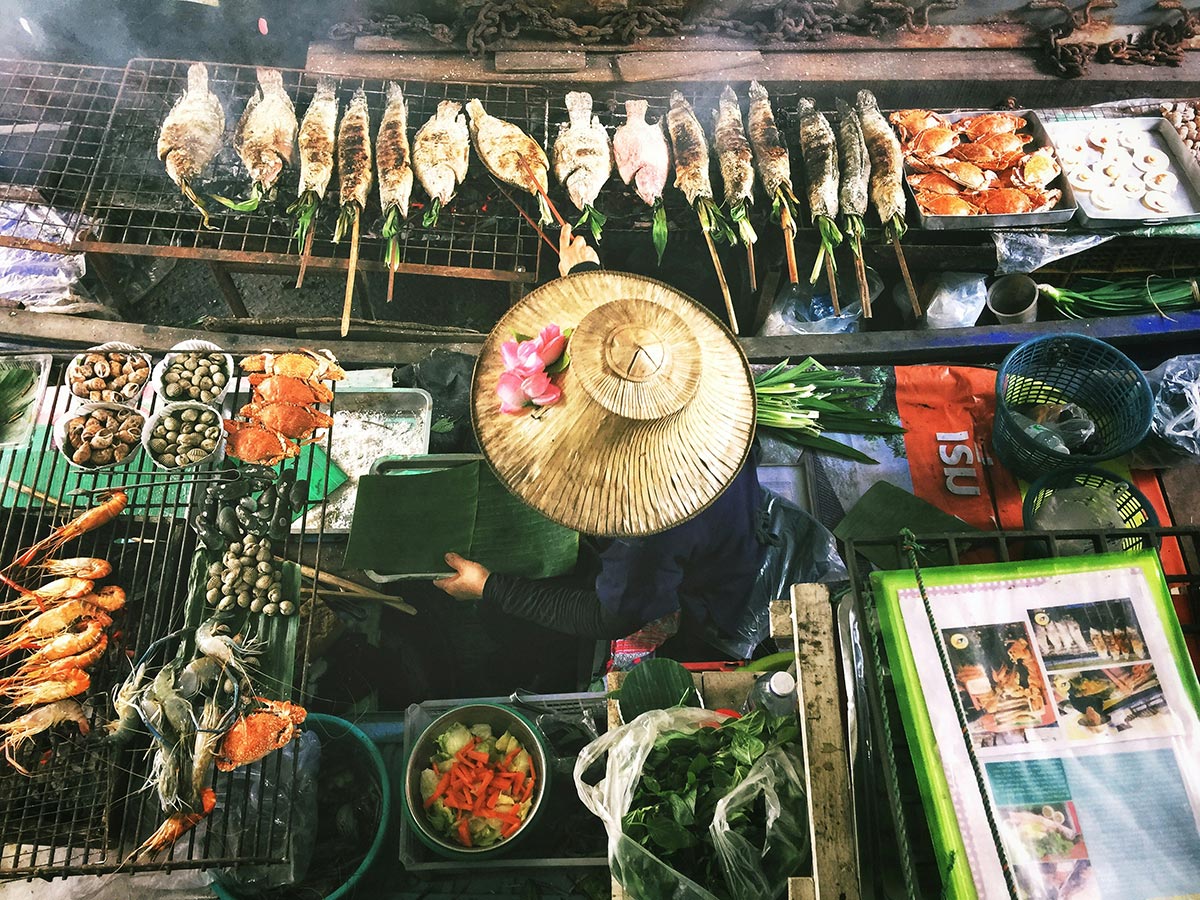
To make sure you don't miss out on any flavours or culinary highlights, we present Thailand's most popular dishes and food spots here. We'll take you on a little gourmet journey across the country and tell you what's important when ordering and at the table.
How to eat in Thailand
- What makes Thailand's cuisine so special?
- How do culture and cuisine go together?
- Chiang Mai
- Ayutthaya
- Bangkok
- Pattaya
- Phuket
- Watch out for spiciness
- ! Chopsticks, fingers or knife and fork?
- Enjoy all the flavours together
- Smacking out of politeness?
How to eat in Thailand
What makes Thailand's cuisine so special? "Delicious" is a matter of personal taste. Nevertheless, we are sure that you will love Thai cuisine. Why? Because there are simply so many different dishes and something for every taste. The following characteristics make the country's cuisine so unique:
- Aromatic balance: From sweet to sour - all flavours come together harmoniously in Thai dishes.
- Different textures: crispy, soft, creamy - you will hardly find a dish that tastes boring. Care is always taken, for example, to combine crunchy salad with spicy sauces and crunchy elements such as peanuts.
- Fresh herbs and spices: As soon as you take a bite of a 'satay' meat skewer or slurp 'tom yum goong' soup, intense flavours unfold in your mouth. This is because herbs and spices such as lemongrass, coriander, garlic and curry play an important role in Thai cuisine.
- Meat, vegetarian, vegan: As Buddhism holds every living being in the highest esteem, many Thai dishes contain little to no meat. And even if you follow a vegan diet, you will find plenty of options on your journey through the country.
Street food that brings you together - culture meets cuisine
Thailand is known for its unique street food culture, which uniquely brings together the country's cuisine and culture. The dishes are more than 'just food'. They reflect the different regions, how people live together here and which values are important in everyday life:
Fresh ingredients show the country's closeness to nature and the appreciation of the food that Mother Earth gives us. International influences in the dishes emphasise the openness to other cultures and countries. The fact that the food is often cooked right in front of you is a symbol of honesty, and the fact that it is customary to order many dishes together and then share them is an act of togetherness. In Thailand, community and sharing play a central role - and there is hardly a better place for this than a table full of goodies.
Foodspots Thailand: where to find the tastiest food

Thai cuisine varies from region to region. While it is still pretty typical in the south, where your mouth is sure to burn with spiciness, it gets a little milder towards the north. That's why we're starting our culinary tour right here and then travelling across the country together. Our stops: 5 cities where we can really savour the flavours.
#1 Chiang Mai
Chiang Mai is located in the north of Thailand - surrounded by mountains and nature. The mix of cosy cafés, tranquil temples, traditional markets and green parks creates a relaxed yet lively atmosphere. Everything in the city is laid back - it's a place where you can take a deep breath without getting bored while exploring the culture and history.
The region's most famous dish is khao soi - a creamy coconut curry soup with egg noodles, crispy toppings and a choice of chicken, beef or tofu. One place where you can eat it particularly well is Khao Soi Khun Yai, a well-known restaurant in the old town.
At the Warorot Market and Sunday Night Market you can also try great street food and dishes such as Sai Ua, a northern Thai sausage or the sweet pancake Khanom Beuang freshly prepared. Or head to Nimmanhaemin Road - a neighbourhood with many trendy cafés and restaurants.
#2 Ayutthaya
Ayutthaya is located on three rivers on an island and for decades was a trading centre where many people and cultures mingled. Accordingly, many influences are also mixed in the cuisine that the region is known for.
When you walk through the streets of the almost mystical city with its historic temple ruins overgrown with roots and trees, you enter an almost meditative mood. The air is calm with a nostalgic flair - and the scent of strong herbs and spices.
Once served from boats on the rivers of Ayutthaya, boat noodles (kuay teow reua) are probably the dish with the longest tradition in Ayutthaya. If you want to savour the hearty noodle soup with beef, pork or offal as it was originally prepared, you should go to Doy Kuay Teow Reua. Or visit one of the street food markets such as the Ayutthaya Floating Market, Bang Lan or Chao Phram. Here you will also find other specialities such as gai yang and som tam (grilled chicken with papaya salad) or one of the many sweet desserts, such as thong yip or roti sai mai - a crêpe-like pastry filled with sweet, colourful candy floss .

#3 Bangkok
From Ayutthaya, you can travel by bus to Bangkok, the capital of Thailand, within 2 - 3 hours. A captivating contrast of tradition and modernity awaits you here. Magnificent temples mingle with new shopping centres, traditional markets with urban skyscrapers, royal history and a colourful party scene.
The city has energy, it pulsates on every street corner. You can simply let yourself drift and be carried away by the dynamism of the metropolis. You can fortify yourself at lively and charming markets such as the Chatuchak Weekend Market or the Train Night Market Ratchada, or take a break in one of the culinary neighbourhoods such as Chinatown (Yaowarat) or in the small street, Sukhumvit Soi 38, which is famous for its street food.
You should order here: Pad Thai (fried rice noodles), Khao Man Gai (chicken with rice), Tom Yum Goong (spicy prawn soup) or Moo Ping (grilled pork skewers).
#4 Pattaya
Originally a quiet fishing village on the Gulf of Thailand - around 150 kilometres south-east of Bangkok - Pattaya has developed into a popular tourist destination in recent years. Depending on where you are in the city, the flair changes from laid-back to going out. The north tends to be quieter, the centre has a lively party scene and the south has relaxed beaches that attract families in particular.
With a beautiful location by the sea, Pattaya enjoys a great reputation when it comes to fresh seafood. You'll find grilled prawns, mussels, crab and squid served with spicy Thai sauces. The best places for this are the Pattaya Floating Market, the Naklua Fish Market or the Mum Aroi Restaurant.
Fish is not one of your favourite dishes? Then dishes such as Pad Krapao (roasted pork or chicken with Thai basil and chillies, served with rice and often a fried egg as a topping) or Khao Gaeng (rice with aromatic curries and side dishes) are a good alternative.

#5 Phuket
A tropical paradise with breathtaking beaches and turquoise seas - welcome to Phuket, the southernmost stop on our little gourmet trip. Covered by rainforests and hills, the island is a true natural wonder with great cultural diversity.
In the kitchen, typical southern Thai dishes meet Chinese and Malay flavours. The result is a unique mix that is often hot and spicy.
If you want an authentic culinary start to the day, you should eat Kanom Jeen Phuket for breakfast - a traditional breakfast dish made from fresh rice noodles flavoured with various curries, herbs and vegetables.
Afterwards, you can stroll through the Phuket Weekend Market and sample the region's specialities at the many stalls. The goong sarong - a special Phuket delicacy in which prawns are wrapped in crispy noodles, deep-fried and then served in a sweet and spicy sauce - is particularly impressive.
You can then round off your day at Mee Ton Poe, one of Phuket Town's best-known addresses for mee hokkien (hokkien noodles) and a favourite among locals for decades.
Tips & rules: How to order and eat your food
To show respect for the locals and to experience the food culture properly, there are certain rules of behaviour at the table in Thailand. Here are the three most important rules, plus a tip on how not to burn your mouth immediately:
Watch out, spicy!
As already mentioned, Thai cuisine tends to be spicy. However, you can choose your own level of spiciness when ordering if you ask politely. Simply explain that you prefer it mild ('not spicy').
Chopsticks, fingers or knife and fork?
Do you find it difficult to eat with chopsticks? Then this rule will make you happy: In Thailand, you eat with a fork and spoon. The fork is actually only used to push the food onto the spoon. You don't need a knife because the dishes are almost always served in bite-sized portions.
Enjoy all the flavours together
A typical feature of Thai cuisine is that you often order several dishes to be eaten together so that everyone can enjoy the variety of flavours. It is rare for someone to take a plate on their own.
Smacking out of politeness?
In some Asian countries, it is considered polite to smack your lips and burp. This is not the case in Thailand. Tranquillity and restraint are important here. It's about savouring consciously. However, the chefs will be delighted to tell you afterwards that you enjoyed it.
Spicy papaya salad, fried noodles with prawns, crispy coconut pancakes, grilled meat skewers with peanut sauce - if you want to experience one of the world's most popular cuisines, you should travel to Thailand. Whether in small street food restaurants or at colourful markets - unique dishes can be discovered everywhere. The variety is incredible, the flavours are exceptionally aromatic and the people who cook the delicacies are super friendly.
Content:
Foodspots Thailand: Here you can find the tastiest food
Tips & Rules: How to order and eat your food



To make sure you don't miss out on any flavours or culinary highlights, we present Thailand's most popular dishes and food spots here. We'll take you on a little gourmet journey across the country and tell you what's important when ordering and at the table.
How to eat in Thailand
- What makes Thailand's cuisine so special?
- How do culture and cuisine go together?
- Chiang Mai
- Ayutthaya
- Bangkok
- Pattaya
- Phuket
- Watch out for spiciness
- ! Chopsticks, fingers or knife and fork?
- Enjoy all the flavours together
- Smacking out of politeness?
How to eat in Thailand
What makes Thailand's cuisine so special? "Delicious" is a matter of personal taste. Nevertheless, we are sure that you will love Thai cuisine. Why? Because there are simply so many different dishes and something for every taste. The following characteristics make the country's cuisine so unique:
- Aromatic balance: From sweet to sour - all flavours come together harmoniously in Thai dishes.
- Different textures: crispy, soft, creamy - you will hardly find a dish that tastes boring. Care is always taken, for example, to combine crunchy salad with spicy sauces and crunchy elements such as peanuts.
- Fresh herbs and spices: As soon as you take a bite of a 'satay' meat skewer or slurp 'tom yum goong' soup, intense flavours unfold in your mouth. This is because herbs and spices such as lemongrass, coriander, garlic and curry play an important role in Thai cuisine.
- Meat, vegetarian, vegan: As Buddhism holds every living being in the highest esteem, many Thai dishes contain little to no meat. And even if you follow a vegan diet, you will find plenty of options on your journey through the country.
Street food that brings you together - culture meets cuisine
Thailand is known for its unique street food culture, which uniquely brings together the country's cuisine and culture. The dishes are more than 'just food'. They reflect the different regions, how people live together here and which values are important in everyday life:
Fresh ingredients show the country's closeness to nature and the appreciation of the food that Mother Earth gives us. International influences in the dishes emphasise the openness to other cultures and countries. The fact that the food is often cooked right in front of you is a symbol of honesty, and the fact that it is customary to order many dishes together and then share them is an act of togetherness. In Thailand, community and sharing play a central role - and there is hardly a better place for this than a table full of goodies.
Foodspots Thailand: where to find the tastiest food

Thai cuisine varies from region to region. While it is still pretty typical in the south, where your mouth is sure to burn with spiciness, it gets a little milder towards the north. That's why we're starting our culinary tour right here and then travelling across the country together. Our stops: 5 cities where we can really savour the flavours.
#1 Chiang Mai
Chiang Mai is located in the north of Thailand - surrounded by mountains and nature. The mix of cosy cafés, tranquil temples, traditional markets and green parks creates a relaxed yet lively atmosphere. Everything in the city is laid back - it's a place where you can take a deep breath without getting bored while exploring the culture and history.
The region's most famous dish is khao soi - a creamy coconut curry soup with egg noodles, crispy toppings and a choice of chicken, beef or tofu. One place where you can eat it particularly well is Khao Soi Khun Yai, a well-known restaurant in the old town.
At the Warorot Market and Sunday Night Market you can also try great street food and dishes such as Sai Ua, a northern Thai sausage or the sweet pancake Khanom Beuang freshly prepared. Or head to Nimmanhaemin Road - a neighbourhood with many trendy cafés and restaurants.
#2 Ayutthaya
Ayutthaya is located on three rivers on an island and for decades was a trading centre where many people and cultures mingled. Accordingly, many influences are also mixed in the cuisine that the region is known for.
When you walk through the streets of the almost mystical city with its historic temple ruins overgrown with roots and trees, you enter an almost meditative mood. The air is calm with a nostalgic flair - and the scent of strong herbs and spices.
Once served from boats on the rivers of Ayutthaya, boat noodles (kuay teow reua) are probably the dish with the longest tradition in Ayutthaya. If you want to savour the hearty noodle soup with beef, pork or offal as it was originally prepared, you should go to Doy Kuay Teow Reua. Or visit one of the street food markets such as the Ayutthaya Floating Market, Bang Lan or Chao Phram. Here you will also find other specialities such as gai yang and som tam (grilled chicken with papaya salad) or one of the many sweet desserts, such as thong yip or roti sai mai - a crêpe-like pastry filled with sweet, colourful candy floss .

#3 Bangkok
From Ayutthaya, you can travel by bus to Bangkok, the capital of Thailand, within 2 - 3 hours. A captivating contrast of tradition and modernity awaits you here. Magnificent temples mingle with new shopping centres, traditional markets with urban skyscrapers, royal history and a colourful party scene.
The city has energy, it pulsates on every street corner. You can simply let yourself drift and be carried away by the dynamism of the metropolis. You can fortify yourself at lively and charming markets such as the Chatuchak Weekend Market or the Train Night Market Ratchada, or take a break in one of the culinary neighbourhoods such as Chinatown (Yaowarat) or in the small street, Sukhumvit Soi 38, which is famous for its street food.
You should order here: Pad Thai (fried rice noodles), Khao Man Gai (chicken with rice), Tom Yum Goong (spicy prawn soup) or Moo Ping (grilled pork skewers).
#4 Pattaya
Originally a quiet fishing village on the Gulf of Thailand - around 150 kilometres south-east of Bangkok - Pattaya has developed into a popular tourist destination in recent years. Depending on where you are in the city, the flair changes from laid-back to going out. The north tends to be quieter, the centre has a lively party scene and the south has relaxed beaches that attract families in particular.
With a beautiful location by the sea, Pattaya enjoys a great reputation when it comes to fresh seafood. You'll find grilled prawns, mussels, crab and squid served with spicy Thai sauces. The best places for this are the Pattaya Floating Market, the Naklua Fish Market or the Mum Aroi Restaurant.
Fish is not one of your favourite dishes? Then dishes such as Pad Krapao (roasted pork or chicken with Thai basil and chillies, served with rice and often a fried egg as a topping) or Khao Gaeng (rice with aromatic curries and side dishes) are a good alternative.

#5 Phuket
A tropical paradise with breathtaking beaches and turquoise seas - welcome to Phuket, the southernmost stop on our little gourmet trip. Covered by rainforests and hills, the island is a true natural wonder with great cultural diversity.
In the kitchen, typical southern Thai dishes meet Chinese and Malay flavours. The result is a unique mix that is often hot and spicy.
If you want an authentic culinary start to the day, you should eat Kanom Jeen Phuket for breakfast - a traditional breakfast dish made from fresh rice noodles flavoured with various curries, herbs and vegetables.
Afterwards, you can stroll through the Phuket Weekend Market and sample the region's specialities at the many stalls. The goong sarong - a special Phuket delicacy in which prawns are wrapped in crispy noodles, deep-fried and then served in a sweet and spicy sauce - is particularly impressive.
You can then round off your day at Mee Ton Poe, one of Phuket Town's best-known addresses for mee hokkien (hokkien noodles) and a favourite among locals for decades.
Tips & rules: How to order and eat your food
To show respect for the locals and to experience the food culture properly, there are certain rules of behaviour at the table in Thailand. Here are the three most important rules, plus a tip on how not to burn your mouth immediately:
Watch out, spicy!
As already mentioned, Thai cuisine tends to be spicy. However, you can choose your own level of spiciness when ordering if you ask politely. Simply explain that you prefer it mild ('not spicy').
Chopsticks, fingers or knife and fork?
Do you find it difficult to eat with chopsticks? Then this rule will make you happy: In Thailand, you eat with a fork and spoon. The fork is actually only used to push the food onto the spoon. You don't need a knife because the dishes are almost always served in bite-sized portions.
Enjoy all the flavours together
A typical feature of Thai cuisine is that you often order several dishes to be eaten together so that everyone can enjoy the variety of flavours. It is rare for someone to take a plate on their own.
Smacking out of politeness?
In some Asian countries, it is considered polite to smack your lips and burp. This is not the case in Thailand. Tranquillity and restraint are important here. It's about savouring consciously. However, the chefs will be delighted to tell you afterwards that you enjoyed it.




























